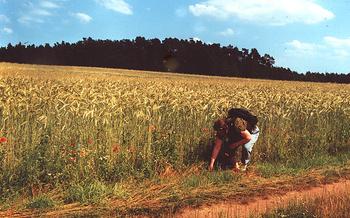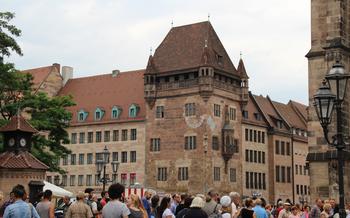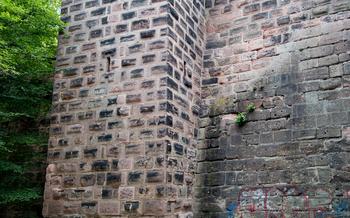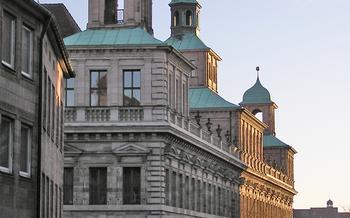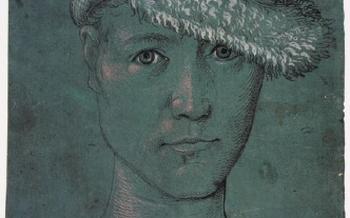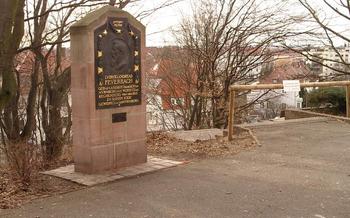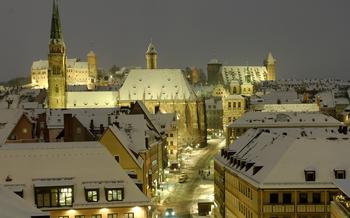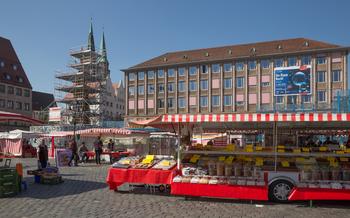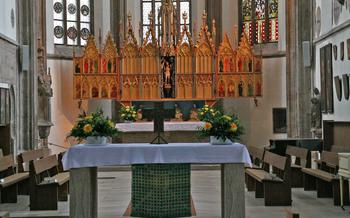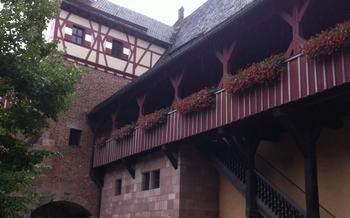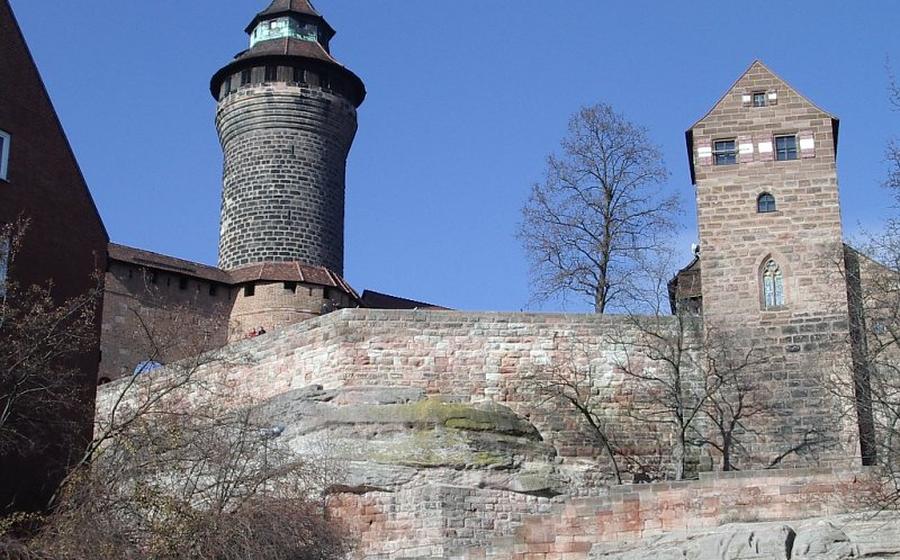
Nuremberg Castle (Kaiserburg)
- Nuremberg Castle (Kaiserburg): A Majestic Symbol of Imperial Power
- Exploring the Castle Grounds: A Journey Through Time
- The Imperial Museum: Uncovering Nuremberg's Rich Past
- The Double Chapel: A Unique Architectural Masterpiece
- The Five Towers: Guardians of the Castle's Legacy
- The Imperial Hall: Witnessing History Unfold
- The Imperial Apartments: A Glimpse into Royal Life
- The Castle in Popular Culture: From Art to Literature
- Transportation to the Castle: Getting There with Ease
- Where to Eat and Drink Near the Castle: Culinary Delights
- Insider Tip: Exploring the Castle's Secret Passages
Nuremberg Castle (Kaiserburg): A Majestic Symbol of Imperial Power
The Nuremberg Castle, also known as the Imperial Castle, stands as a testament to the city's rich history and its significance in the Holy Roman Empire. Founded in the 11th century, the castle served as a residence for the emperors and held a pivotal role in imperial politics and decision-making.
Its imposing silhouette, perched on a sandstone hill overlooking the city, speaks volumes about the castle's architectural prowess. The mighty walls, fortified towers, and grand halls reflect the power and prestige of the imperial court. Visitors are awed by the sheer size and grandeur of the castle, which has withstood the test of time and remains one of Germany's most impressive medieval fortresses.
Beyond its architectural splendor, the Nuremberg Castle played a crucial role in the functioning of the Holy Roman Empire. It served as a venue for imperial diets, where rulers, electors, and representatives from across the empire gathered to discuss matters of governance, law, and diplomacy. These meetings shaped the political landscape of medieval Europe, making the castle a hub of power and influence.
Exploring the Castle Grounds: A Journey Through Time
The castle grounds offer a captivating journey through history, with each corner revealing a unique story. In the inner courtyard, you'll find the Imperial Chapel, a stunning example of Gothic architecture with its intricate carvings and colorful stained-glass windows. It served as a sacred space for the emperors and their court, hosting religious ceremonies and royal events.
The Sinwell Tower, also known as the Torture Tower, stands as a chilling reminder of the castle's darker past. Its ominous chambers once housed prisoners and witnessed the horrors of medieval justice. The deep well, located in the courtyard, provided a vital water source for the castle's inhabitants during times of siege and hardship.
The Imperial Museum: Uncovering Nuremberg's Rich Past
The Imperial Museum, housed within the walls of the Nuremberg Castle, is a treasure trove of historical artifacts and exhibits that narrate the captivating story of Nuremberg's past. Wander through its galleries and immerse yourself in interactive displays that bring the city's rich history to life. Admire medieval weaponry, intricate armor, and fascinating relics that offer a glimpse into the lives of the emperors and nobles who once resided within these castle walls.
Temporary exhibitions add a dynamic dimension to the museum, delving into specific periods or themes related to Nuremberg's history. Curated with care and attention to detail, these exhibitions showcase unique artifacts, documents, and multimedia presentations that offer fresh perspectives on the city's cultural, political, and social development.
The Double Chapel: A Unique Architectural Masterpiece
The Double Chapel, or Doppelkapelle, is an architectural marvel that stands as a testament to Nuremberg's rich history and religious heritage. Built in the 14th century, it's a unique masterpiece that seamlessly blends Romanesque and Gothic architectural styles. The Romanesque lower chapel, with its vaulted ceiling and sturdy columns, exudes a sense of grandeur and strength. In contrast, the upper chapel, constructed in the Gothic style, features intricate ribbed vaulting and delicate tracery windows, creating an atmosphere of lightness and spirituality.
The Verbindungsbau, or connecting building, serves as a bridge between the two chapels. This ingenious architectural feature allowed the emperor and his court to attend mass in the upper chapel without having to mingle with the commoners in the lower chapel. The Verbindungsbau is adorned with stunning frescoes depicting scenes from the life of Christ, adding to the chapel's visual splendor.
Throughout the chapel, visitors can marvel at the exquisite frescoes and sculptures that adorn its walls and ceiling. These intricate works of art depict biblical stories, saints, and historical figures, providing a glimpse into the religious and cultural beliefs of the time. The symbolism and religious significance embedded in these artworks make the Double Chapel not just a place of worship but also a repository of profound spiritual and artistic expression.
The Five Towers: Guardians of the Castle's Legacy
The Nuremberg Castle boasts five imposing towers that stand as silent witnesses to the castle's rich history. Each tower served a specific purpose and contributed to the castle's overall defense and functionality.
The Fünfeckturm (Five-Cornered Tower), with its unique pentagonal shape, provided a commanding view of the surrounding landscape and served as a watchtower. The Luginsland (Lookout Tower), perched high above the city, offered a breathtaking panorama and allowed the castle's inhabitants to keep an eye on approaching visitors or potential threats.
The Vestnerturm (Vestner Tower), named after the Vestner family who once resided in the castle, served as a residential tower and provided living quarters for the castle's guards. The Frauentorturm (Women's Tower), believed to have been used as a prison for women, adds a touch of mystery to the castle's history.
Finally, the Tiergärtnertorturm (Animal Keeper's Tower), located near the castle's gardens, served as a residence for the animal keeper who tended to the exotic animals kept within the castle walls.
These five towers, each with its own unique story to tell, stand as proud symbols of the castle's rich past and architectural ingenuity, inviting visitors to explore their hidden corners and unravel their secrets.
The Imperial Hall: Witnessing History Unfold
Amidst the grand chambers of the Nuremberg Castle, the Imperial Hall stands as a testament to the castle's illustrious past. This magnificent banqueting hall, with its soaring ceilings and intricate carvings, served as the stage for countless imperial feasts, ceremonies, and events that shaped the course of history.
Originally constructed in the 13th century, the Imperial Hall underwent several renovations and expansions over the years, reflecting the evolving tastes and requirements of the Holy Roman Emperors who resided in the castle. Its grand dimensions and opulent decorations were designed to impress visitors and reinforce the emperor's authority and power.
The hall's most striking feature is its elaborate ceiling, adorned with intricate carvings and paintings depicting scenes from the Bible, mythology, and imperial history. These intricate artworks, created by skilled craftsmen, served as a visual representation of the emperor's divine right to rule and his connection to the divine.
Throughout the centuries, the Imperial Hall witnessed countless historical events that left an indelible mark on the castle's legacy. It was here that emperors were elected, coronations were held, and important decisions were made that affected the fate of nations. The hall's walls echoed with the laughter, music, and conversations of emperors, princes, and dignitaries who gathered for lavish banquets and celebrations.
In the 19th century, the Imperial Hall underwent a comprehensive restoration, returning it to its former glory. Today, it stands as a beautifully preserved example of medieval architecture and a reminder of the castle's rich history. Visitors can explore the hall, marveling at its grandeur and imagining the echoes of history that still linger within its walls.
The Imperial Apartments: A Glimpse into Royal Life
The imperial apartments within the Nuremberg Castle offer a fascinating glimpse into the lives of the emperors who once resided here. These beautifully preserved living quarters showcase period furnishings, intricate tapestries, and elegant decor that transport visitors back in time to the days of imperial rule.
Each room within the apartments has its own unique story to tell, from the grand Schlafzimmer (bedroom) with its opulent four-poster bed to the cozy Wohnzimmer (living room) with its inviting fireplace. The Kemenate (private chamber) provides an intimate glimpse into the personal lives of the emperors, while the Schreibzimmer (study) evokes images of rulers pondering matters of state.
Visitors can wander through these historic spaces, admiring the fine craftsmanship and attention to detail that went into every element of the design. The apartments offer a tangible connection to the past, allowing visitors to imagine the daily lives of the powerful figures who once called the Nuremberg Castle home.
The Castle in Popular Culture: From Art to Literature
The Nuremberg Castle has captured the imagination of artists, writers, and filmmakers throughout history. Its imposing architecture and rich history have served as inspiration for numerous works of art, literature, and popular culture.
In the realm of painting, Albrecht Dürer, a renowned Renaissance artist from Nuremberg, immortalized the castle in several of his works, including the famous "Nuremberg Castle" watercolor. His detailed depictions showcase the castle's grandeur and its significance as a symbol of the city.
The castle's literary presence is equally notable. E.T.A. Hoffmann, a German Romantic writer, featured the castle prominently in his novella "The Golden Pot." In his tale, the castle becomes a magical place where the protagonist experiences extraordinary adventures.
In recent times, the Nuremberg Castle has made its way onto the silver screen. It served as a dramatic backdrop in the 1961 film "Judgment at Nuremberg," which explored the aftermath of the Nuremberg Trials. The castle's imposing presence added an air of historical authenticity to the film's powerful narrative.
Beyond these notable examples, the castle's distinct silhouette and intriguing history continue to captivate artists, writers, and filmmakers, ensuring its enduring legacy in popular culture.
Transportation to the Castle: Getting There with Ease
Reaching the Nuremberg Castle is a breeze, with a variety of transportation options at your disposal. Public transportation is a convenient choice, with buses and trams stopping right at the castle's doorstep. The closest stop is "Kaiserburg", served by bus lines 36 and 46, as well as tram line
For those who prefer a more scenic route, a leisurely walk or bike ride to the castle is a fantastic option. From the city center, it's a pleasant 15-20 minute stroll along the picturesque streets, offering stunning views of the castle as you approach.
If you're arriving by car, there are several parking options available nearby. The closest one is the "Kaiserburg" parking garage, located just a short walk from the castle entrance. Alternatively, street parking is available in the surrounding streets, but be prepared for limited spaces and potential fees.
To make your journey even more memorable, consider exploring the castle's surroundings on two wheels. Bike rental shops are scattered throughout the city, allowing you to rent a bicycle and embark on a scenic ride through the historic streets and parks.
No matter your preferred mode of transportation, getting to the Nuremberg Castle is a breeze. So, prepare to be captivated by the grandeur of this imperial fortress and immerse yourself in the rich tapestry of history that unfolds within its walls.
Where to Eat and Drink Near the Castle: Culinary Delights
A visit to the Nuremberg Castle is not complete without indulging in the city's culinary delights. The area surrounding the castle offers a diverse range of dining options, from traditional Franconian cuisine to international flavors.
For a taste of local specialties, head to one of the many traditional Franconian restaurants near the castle. Try dishes like Schäufele (roasted pork shoulder), Nürnberger Rostbratwürste (grilled Nuremberg sausages), or Bratwürste mit Kraut (sausages with sauerkraut).
If you're looking for something different, there are several international restaurants to choose from. Enjoy Italian pasta, Japanese sushi, or Indian curry, all within walking distance of the castle.
For a quick bite or a refreshing drink, there are several cafés and bars near the castle. Relax with a cup of coffee and a slice of cake, or enjoy a cold beer or glass of wine while taking in the views of the castle and the city.
Here are a few personal recommendations:
- Zum Albrecht Dürer: A traditional Franconian restaurant with a cozy atmosphere and a wide range of local specialties.
- Das Schwarze Schaf: A modern restaurant with a creative take on traditional Franconian cuisine.
- Café am Trödelmarkt: A charming café with a lovely outdoor seating area, perfect for enjoying a coffee and a slice of cake.
- Bar am Burgberg: A stylish bar with a great selection of cocktails and live music on weekends.
Insider Tip: Exploring the Castle's Secret Passages
Beneath the majestic Nuremberg Castle lies a hidden world of secret passages and underground chambers, a testament to the castle's rich and intriguing history. These subterranean tunnels, once used for various purposes such as escape routes, storage, and even as a prison, offer a unique and unforgettable experience for visitors.
Join a guided tour to delve into the depths of the castle's hidden realms. Knowledgeable guides will lead you through narrow corridors, revealing the stories and legends associated with these mysterious spaces. Discover the strategic importance of the tunnels during times of siege, imagine the footsteps of medieval guards patrolling the underground passages, and feel the chill of history as you explore these hidden depths.
Special events and exhibitions are occasionally held within the secret passages, providing a truly immersive experience. These events often showcase historical reenactments, interactive displays, and multimedia presentations, bringing the castle's past to life in a captivating way.
Exploring the secret passages of Nuremberg Castle is like embarking on a journey through time. It's an opportunity to uncover hidden treasures, unlock forgotten stories, and gain a deeper appreciation for the castle's enduring legacy. Prepare to be amazed and intrigued as you venture into the unknown, discovering the secrets that lie beneath the surface of this iconic landmark.
